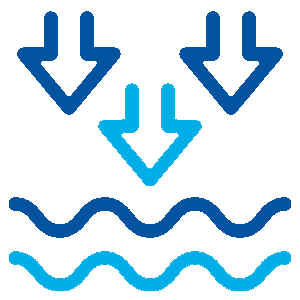
How to Balance Cyanuric Acid in a Pool
Being a great pool owner is a balancing act — literally! Maintaining an ideal water chemistry balance within your pool can seem like a never-ending chore. Well, what if we told you there is a chemical that can actually prolong the use and effectiveness of your ever-important chlorine? That's right, we're talking about Cyanuric Acid!
If you're unfamiliar with Cyanuric Acid, think of it like chlorine's bodyguard. Also known as a pool water "stabilizer" or "conditioner," Cyanuric Acid's main job is to stabilize and protect the chlorine in your water. The more effective your chlorine is, the more sanitized your pool water will be.
Why is Cyanuric Acid Important?

Cyanuric Acid is like sunscreen for your pool water’s chlorine. Much like your skin, chlorine particles are sensitive to the sun’s UV rays. When the rays hit chlorine particles, they destabilize, break apart, and subsequently evaporate out of the pool water. Enter, Cyanuric Acid. Like a strong SPF on your skin, Cyanuric Acid binds to the chlorine particles and protects them from the sun’s UV rays.
This helping hand from Cyanuric Acid drastically prolongs the life of the chlorine. If left unprotected, UV rays can destroy up to 90% of the chlorine in your pool in just two hours! Not only is that a huge waste of money, but it also leaves your pool without any sanitizing abilities.
BONUS TIP: If your Cyanuric Acid level is above 60 ppm, it can skew Total Alkalinity results in water tests, making it appear higher than it actually is. Leslie's free in-store AccuBlue® water test takes this into account to provide you with the most accurate water test results available.
Testing for Cyanuric Acid in Your Pool
As with all other pool water chemicals, it is important to test Cyanuric Acid levels weekly. Regular testing helps identify problems early, and prevents them from getting out of hand. Ideally, your pool’s Cyanuric Acid level should be between 30–100 ppm (parts per million). However, it is important to know what form of chlorine you use in your pool before you start adding Cyanuric Acid.
Stabilized vs. unstabilized chlorine
Dogs or cats? Stabilized or unstabilized chlorine? Life is full of complicated choices. Thankfully, deciding what chlorine is best for your pool is anything but. If you’re not sure what the difference is between stabilized and unstabilized chlorine, don’t stress. That’s why we’re here! Simply put, stabilized chlorine contains Cyanuric Acid, and unstabilized chlorine does not. Now the question is, which one should you use in your pool?
Stabilized chlorine: Also known as sodium dichlor and trichlor, stabilized chlorine is suitable for use in outdoor pools. Since Cyanuric Acid is already compounded into this form of chlorine, you don't have to worry as much about sun exposure. If starting with a freshly-filled pool, add conditioner to get your Cyanuric Acid levels up to the low end of the ideal range, or around 30 ppm. While using stabilized chlorine, your Cyanuric Acid levels will increase over time. Generally speaking, Cyanuric Acid levels only go down with excessive splash-out, if there's a pool leak, or during backwashing. Test your water often to keep track of Cyanuric Acid levels in your pool.
Unstabilized chlorine: Available as calcium hypochlorite (cal-hypo) or sodium hypochlorite (liquid chlorine), unstabilized chlorine is a common primary sanitizer for indoor pools and commercial/public pools, or it can be used to shock outdoor pools. Another type of unstabilized chlorine is generated in salt pools with the help of saltwater chlorine generators. Because this form of chlorine does not contain Cyanuric Acid, if using it as a primary sanitizer, you must add stabilizer separately. Start with a Cyanuric Acid level between 30–100 ppm, and add more as needed to maintain this ideal range.
How to Raise the Cyanuric Acid Level
Increasing the level of Cyanuric Acid in your pool is fairly simple. If the level drops below 30 ppm in your outdoor pool, you will need to add a granular or liquid water conditioner to your pool. Remember, Cyanuric Acid is also referred to as a pool water conditioner or stabilizer. This is because it stabilizes and conditions the chlorine in the water to protect it against the sun.
Pool water conditioners come in liquid and granular forms. Many pool owners prefer liquid conditioners because they dissolve and incorporate into the water faster than the granular form. For more information, check out our blog article about adding conditioner to the pool.
EXPERT TIP: 4 ounces of Leslie's Instant Pool Water Conditioner will increase the Cyanuric Acid level by 1 ppm in a 10,000-gallon pool. Follow this helpful guide to determine how many gallons are in your pool.
It's important to note that using a conditioner can affect your pool water's pH balance. The ideal pH range is 7.4–7.6. Before you treat with conditioner, test the water to know what the current pH level is.
How to Lower the Cyanuric Acid Level

When using stabilized chlorine or adding extra Cyanuric Acid to your pool, it is crucial to frequently test your pool water. Too much Cyanuric Acid can affect the oxidizing capabilities of the chlorine in your pool, leading to sanitization inefficiencies, algae blooms, cloudy water, inaccurate water test results, and other issues. If you find the Cyanuric Acid level is above 100–125 ppm, you may need to bring the level down in order to maintain clean and healthy pool water.
The only way to reduce Cyanuric Acid is to dilute your pool water. Start by draining one foot at a time, and then refill with fresh water. Once refilled, test the water again to see where the Cyanuric Acid level is at. You may need to repeat this process more than once, depending on the amount of Cyanuric Acid in your pool water. Don't hesitate to contact a pool professional for assistance in draining your pool. Check out our blog post, Pool Draining 101 for tips on safe and effective draining.
Cyanuric Acid can be a helpful tool, or a thorn in your side! Maintaining a proper balance of it will keep your pool's chlorine working harder and longer. If you use stabilized chlorine in your pool, test the water at least once a week to keep tabs on the Cyanuric Acid level. If you use unstabilized chlorine, don't let the sun destroy its potency. Adding Cyanuric Acid will save you time and money by prolonging the effectiveness of the chlorine.
Bring a pool water sample to your local Leslie’s to take advantage of our always free in-store AccuBlue water test and customized treatment plan. We'll help you diagnose the problem, and develop a specific plan for your pool.